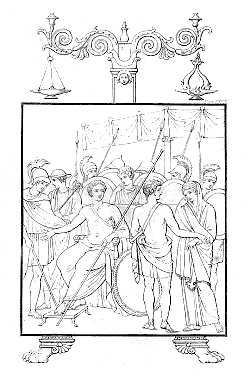Plate XXXIX - Achilles and Briseis
|
The painting of Achilles and Briseis, of which the
outlines are attempted to be given in plate XXXIX,
might, when first discovered, be considered as the
finest specimen of the ancient art of painting which
had come down to us, and was, probably, the faint
resemblance of some celebrated picture by one of the
great masters of Greece. It was impossible to describe
the atrium of the Poet without dwelling on this
beautiful production, so that it needs no further
description. The traveller will look in vain for this
treasure in the spot it once occupied, as it is
removed, after having undergone the inclemency of two
or three seasons, to the Museum at Naples. Had the
house, which might have been covered in at a small
expense, been restored, we might have had a lower floor
at least, nearly as perfect as it existed before the
fatal eruption. The subject of a restoration has indeed
often been thought of by the directors, and the
academicians have even met to consult on the subject.
Unfortunately one insists upon it that the
atrium was covered, while another declares that
no roof whatever existed : the voice of authority which
might decide is not always either interested in or
learned upon the subject, and the House of Pansa, which
had been selected, is now in a state of irretrievable
decay : that of the Poet has followed it ; and the
mansion called that of the Dioscuri, which, for
a trifle, might have been restored to its original
splendour, is hastening to a state of nakedness and
desolation. |
